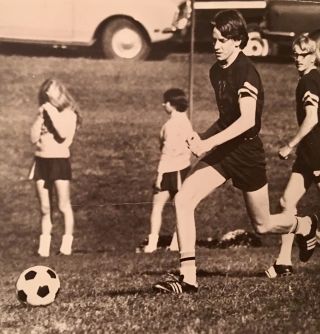Burnout
A Lesson on Burnout From My Son
A Personal Perspective: Mindful engagement builds resilience.
Posted September 5, 2023 Reviewed by Michelle Quirk
Key points
- We can spend much time with people and activities, and not truly engage with them.
- We often "sleepwalk" through relationships and experiences that could bring us much wonder and meaning.
- Engagement involves opening ourselves up to the people and experiences of our lives.
I’ve spent a lot of time over the past 15 years studying burnout and have learned that active engagement in our relationships and endeavors is a powerful prophylaxis against the entity. Indeed, we know that mindfully paying attention to, and interacting with, the people, situations, and places around us is a great way to build personal resilience and foster it in others. I wish I had understood this in my early years as a father and a surgeon.
Creating a Miniature Me

As a kid, I was involved in one athletic activity or another every second of my free time. My father, however, was always “too busy” to make a game, to give me critical pointers, to work on my skills, or to prep me for a match. When my three sons came along, I swore that I would do better. That I would be there for them, every step of the competitive way. And I was. In fact, I was a case study in parental overinvolvement—turning our home into an athletic club—pushing, prodding, and cajoling the boys to join me in one game after another of heavily coached touch football, soccer, baseball, basketball, and the like.
But son number two, Colin, frequently disappeared from my sessions. When I would track him down, I'd find him in our Silence-of-the-Lambs basement meticulously building rockets or tinkering with a chemistry set. And, truth be told, it would irritate me. I, as a neurosurgeon at a Level One Trauma Center, was working from dawn to dusk every day, was taking call every third night, and was caring for scores of critically ill patients every week. Didn’t he get that it took supreme effort to carve out those precious minutes from my bursting-at-the-seams schedule? To fight off the omnipresent fatigue I suffered in order that I might coach him and his brothers to kick, throw, and shoot better than their classmates?

One evening, upon my return home from work, Colin asked if I would camp out with him in the backyard so that we could watch together a major meteor shower.
Without a moment’s hesitation, I begged off. “Oh, Colin, I don’t think so. I’m beat. And I’m on call tomorrow. I just can’t. Perhaps some other time, buddy.”
Colin accepted this with an all-too-familiar look of resignation. A few nights later, at a rare family dinner together, I asked him how his meteor shower went. His eyes went wide and sparked with fevered wonder and marvel.
“Oh my gosh, Dad, it was unbelievable! They were coming every few seconds. Some burst into flames! Some even made roaring sounds,” he said as he painted the arcs of the fireballs in the imaginary night sky over his head.
I froze. And choked up. I couldn’t speak, couldn’t utter a sound. Tears filled my eyes—as they do now, relating this story—as they do every time I relate it or just picture it in my mind. My sweet little absent-minded professor, lying out in the cold autumn night, cocooned in his sleeping bag, breath crystalizing in the frigid air, staring with awe at the cosmic light show above, contemplating the mysteries of the universe…all by himself.

Being There Without Being There
I had an epiphany. I realized that I had been sleepwalking through my relationships with my boys. I had forced upon them a model of interaction that had fit my wants and needs, but not necessarily theirs. I had failed to truly engage with them—watch them, listen to them, hear them—indulge their dreams and wishes. In fact, I realized that I didn’t truly know them. I had no idea what inspired or thrilled or frightened them. I had been trying to create mini-models of myself, not allowing them to realize their own selves.

And, it dawned on me, that I'd been sleepwalking at work as well. Sure, I delivered good technical care, but I wasn’t truly engaging with my patients. I didn’t pick up on their independent personalities or their needs from me. They all had blurred into categories of “cases” rather than being allowed to be unique individuals. My responses to them, my counseling, my consoling, was all canned. Pull a string in my back and you would have gotten one of a handful of rotating messages.

I vowed to do much better—at home and at work. Sometimes I succeeded. Sometimes I didn’t. But I made the effort to mindfully engage my family and friends, my patients and their families, and my coworkers with purposeful attention. At home, this meant I spent much more time firing off rockets (and then searching for them in nearby woods). At work, I began treating my patients as individual people, not cases, and listening to them—actually listening.
The Critical Nature of Engagement
In studying resilience building, we learn that burnout correlates poorly with time spent at work or lack of time spent at home. Instead, it correlates with lack of engagement in both worlds. With purposeful and mindful engagement, we open the door to noticing things. Noticing the splendid individuality of each of our children, noticing the caring and devotion of our life partners, noticing the dedication and skills of our co-workers, and, if we're in health care, noticing the bravery and grace of our patients. When we do this, we replenish our stores of all-so-important emotional energy.
Just being present doesn’t cut it. Engagement is key, lest we sleepwalk through our lives, lest we miss out on its thrills and chills. Experiencing, feeling, and connecting make all the difference. Quality is far more important than quantity. And I have my son, those many years ago, to thank for teaching me this.
References
Simonds, G., Sotile, W. (2018) The Thriving Physician: How to Avoid Burnout by Choosing Resilience Throughout Your Medical Career. Huron Consulting Group, ISBN-10 1622181018
Hodkinson, A., et aL. Associations of physician burnout with career engagement and quality of patient care: systematic review and meta-analysis (2022). BMJ. 2022 Sep 14;378:e070442. doi: 10.1136/bmj-2022-070442.
PMID: 36104064 PMCID: PMC9472104 DOI: 10.1136/bmj-2022-070442
Melanie D Hetzel-Riggin, M., et al. (2020). Work Engagement and Resiliency Impact the Relationship Between Nursing Stress and Burnout. 2020 Oct;123(5):1835-1853. doi: 10.1177/0033294119876076. Epub 2019 Sep 11. PMID: 31510876 DOI: 10.1177/0033294119876076
Simonds, G., Sotile, W. (2019) Thriving in Healthcare: A Positive Approach to Reclaim Balance and Avoid Burnout in Your Busy Life. Huron Consulting Group, ISBN-10: 1622181085




